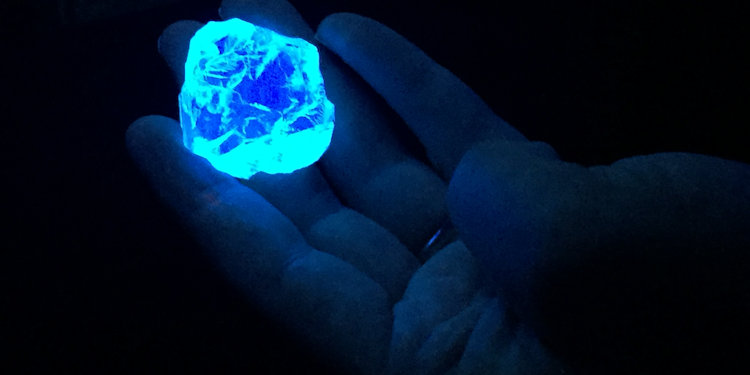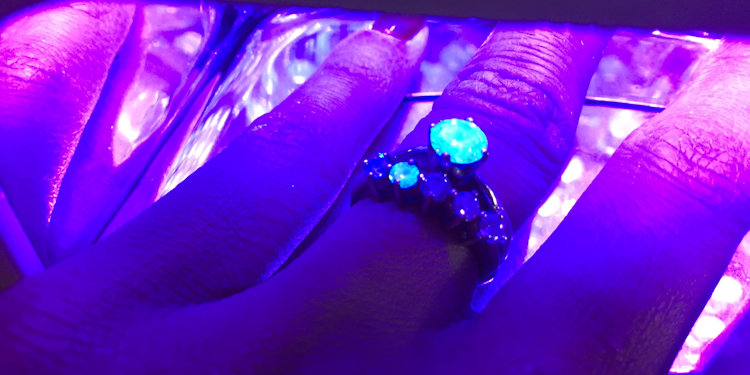
Other Fluorescence Related Articles
Historical Perspective: Fluorescence in Famous Diamonds
The Role of Fluorescence in Synthetic vs. Natural Diamonds: A Comparative Study
Exploring Cultural Perceptions of Fluorescent Diamonds Across the World
Color Enhancement: How Fluorescence Can Improve the Look of Lower Grade Diamonds
Investigating the ‘Overblue’ Phenomenon in Fluorescent Diamonds
The Psychology of Buying: How Fluorescence Affects Consumer Choices in Diamonds
The Intricate Relationship Between Diamond Fluorescence and Its Pricing Dynamics
Diamond Fluorescence: Nature’s Secret Glow
The impact of fluorescence on gem value? For some time, there’s been significant discussion in professional circles related to diamonds concerning the fluorescence of these stones and its influence on value. We aim to touch upon this topic, drawing from insights provided by the renowned Rapaport Magazine, a key reference in diamond pricing.
Primarily, the influence on a gem’s price hinges on fluorescence intensity and its visibility. Consider that in some (not all) stones of superior color, fluorescence can induce a milky effect, reducing its value. However, there are instances where fluorescence doesn’t alter the gem’s appearance.
Interestingly, blue fluorescence can occasionally enhance certain diamonds, especially those of lower color grades like “J” or below. The blend of yellowish hues with blue fluorescence renders the stone whiter, potentially elevating its worth.
A point of debate is the price deduction applied to diamonds exhibiting yellow or white fluorescence. Some of these stones face up to a 5% markdown from their potential value without such fluorescence. Furthermore, the finer the color of these diamonds, the more pronounced the price reduction.
Yet, it’s essential to understand that diamond fluorescence is gauged using specific ultraviolet lamps. Specifically, long wave ultraviolet light at 366 nm and short wavelength ultraviolet light at 254 nm. Thus, sunlight, ranging between 700 nm and 400 nm, may or may not activate the fluorescence phenomenon in stones exposed to ultraviolet.
Fluorescence results from certain minerals’ luminescence when exposed to ultraviolet (UV) light. In the context of diamonds, this reaction is instigated by trace elements in their composition. Roughly 25% to 35% of market diamonds display fluorescence under UV light, with luminescence typically being bluish, yellow, or occasionally orange.

Moreover, the Gemological Institute of America (GIA) does not consider the fluorescence of a diamond as a graduation factor (as the 4 C’s) and YES as an identifying characteristic. Thus, it is described according to its intensity (None, weak, medium, strong, and very strong). The fluorescence is more evident in the medium intensities, strong and very strong and we must consider the following factors:
Color of Fluorescence
Bluish-coloured fluorescence may make the diamond yellowish (GIA-I “M” grading) appear more colorless when exposed to UV light or natural light (sun). For example, a diamond having a blue (medium to very strong) fluorescence and a “J” color gradation appears to have an “H” color gradation when viewed in the sunlight. In contrast, a diamond that has yellow fluorescence exhibits a more yellowish color when observed in the sunlight, thus decreasing its color gradation.
Intensity of fluorescence
When the diamond exhibits a very strong intensity blue fluorescence, this characteristic causes a greater interference in its color gradation. In this case, a negative value is expected due to the “stigma” created by the market, and a discount range of up to 15% is offered on diamonds with this feature, although large discounts are rare.
Market Stigmata
Diamonds of “D” and “H” color gradations that exhibit blue fluorescence are considered less desirable in the market. Some practitioners believe that very strong blue fluorescence causes a blurry or oily appearance in diamonds, however, studies conducted in 1997 by the Gemological Institute of America indicate that people with ordinary visual acuity (and no scientific training for such analysis) cannot perceive this interference with the diamond’s appearance.
-
Diamonds with blue fluorescence of strong / very strong intensity usually have a blurred appearance
-
Diamonds with medium intensity blue fluorescence rarely have a “blurred/blurry” appearance
-
Diamonds with light/weak blue fluorescence never presented a “blurred/blurred” appearance
On the other hand, Michael agrees that blue fluorescence generally interferes with the color grading of the diamond and gives advice to buyers: if you are buying a diamond with an “H” or lower color gradation, look for a diamond with medium intensity blue fluorescence. We are hesitant to suggest that you look for a diamond with strong blue fluorescence, knowing that even in the lower color gradations there is a possibility that the diamond may have a milky or blurry appearance. However, the lower the color gradation, the lower the likelihood of the diamond presenting a milky appearance.
Regarding the burden caused by the pricing:

The following table indicates the devaluation in the price of diamonds with intense blue fluorescence.
| Fluorescence | |||||
| Color | Purity | Weak | Average | Strong | Very strong |
| D-F | IF – VVS2 | up to -1% | from -3% to -7% | from -7% to -10% | up to -15% |
| VS1 – VS2 | No loss | from -1% to -2% | from -3% to -5% | to 10% | |
| SI1 – I3 | No loss | No loss | up to -1% | up to -3% | |
| G-H | IF – VVS2 | up to -1% | from -1% to -3% | from -3% to -5% | from -7% to -10% |
| VS1 – VS2 | No loss | up to -2% | from -2% to -3% | to 10% | |
| SI1 – I3 | No loss | No loss | No loss | No loss | |
| I-M | IF-I3 | No loss | up to -2% | up to -2% | up to -2% |